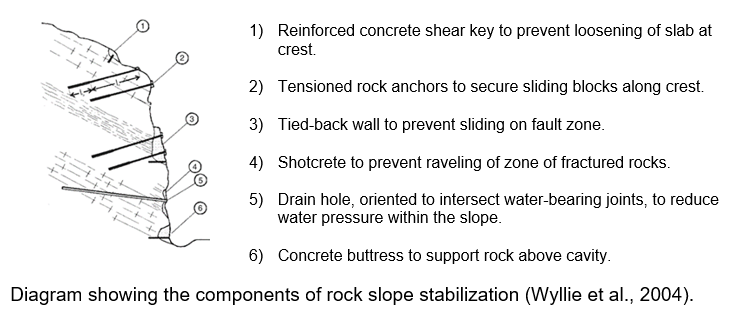
Basic Function:
Rock slope stabilization is used primarily as a preventative measure for both man-made and naturally occurring rock faces but is also implemented as a solution to rock slides, discontinuities in a rock face, or any detected instabilities that would present a danger to the integrity of the rock face.
Advantages:
- Reduces the risks of landslides or slope failures
- Reduces the risks of falling rocks
- Allows for projects to be maintained for longer periods of time
General Description:
Rock slope stabilization is a broad term for infrastructure engineered to reduce the risk of slope failure on a rock face. The three main methods for increasing stability are altering slope geometry, adding reinforcements to the rock face, and installing drainage. Rock slope reinforcement is another umbrella term that includes technology installed internally or externally to improve the shear strength along the rock face and decrease the likelihood of landslides or falling rocks. For reinforcement, there are multiple construction options. Injectable resins, rock bolts, tieback walls, and shotcrete are among the most common and are used for different situations. Injectable resins are pumped into the cracks of the face to improve the integrity of the rock mass. Rock bolts subject the failure area to compressive forces and are installed into solid rock mass. Tieback walls are used in situations where closely fractured rock masses can be susceptible to sliding, and an anchor would have a danger of breaking apart the rock even more. Shotcrete is used by itself or in conjunction with another method to protect against further degradation of the rock face.
Geologic Applicability:
- Rock slope stabilization is applicable for any rock slope deemed of having a high potential for failure by an engineer.
- Rock slope reinforcement is usually implemented pre-excavation, as it stops the rock mass from loosening or relaxing when excavation takes place. Once a rock mass relaxes, it is irreversible, and the shear strength decreases.
Construction Methods:
Construction methods for rock slope stabilization are dependent on the method(s) utilized. For any method, adequate site investigation and preparation should be conducted before construction commences. Then, any loose rocks are removed from the rock face through scaling. Depending on the solution for stabilization, drainage and slope reinforcements will be installed. Quality control tests or further monitoring of slope may be required based on the solution selected for stabilizing the rock slope.
Additional Information:
TBD
SHRP2 Applications:
- Roadway and Embankment Widening
Example Successful Applications:
- Mythimna Castle, Lesvos Island, Greece
- British Columbia, Canada
- Boston, Massachusetts
Complementary Technologies:
Rock slope stabilization is generally a stand-alone technology. If soil slopes are also present, MSE walls or shoot/screw-in nails can be used.
Alternate Technologies:
Drilled/Grouted and Hollow Bar Soil Nailing, MSE walls, reinforced soil slopes, or shoot/screw-in nails
Potential Disadvantages:
- Several of the techniques utilized for stabilization feature permanent alterations, and cannot be undone (blasting or scaling)
- Some of the desired stabilization techniques detract from the perception of the surrounding environment and its natural aesthetic
Key References for this technology:
Wyllie, D. C., Mah, C. W., Hoek, E., & Bray, J. (2009). Rock Slope Engineering - Civil and Mining. New York, NY: Spon Press.
